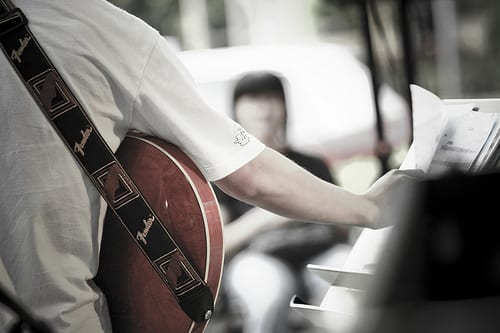 One of the best parts about learning music is figuring out how to recreate and play your favorite songs. It’s amazing what you can accomplish after learning a few of the basics! And when it comes to music transcription, it’s not as difficult as it may seem. Here, Brooklyn guitar teacher Mike B. shares his process…
One of the best parts about learning music is figuring out how to recreate and play your favorite songs. It’s amazing what you can accomplish after learning a few of the basics! And when it comes to music transcription, it’s not as difficult as it may seem. Here, Brooklyn guitar teacher Mike B. shares his process…
So, you just heard a new song you love on the radio. And you’ve just started learning guitar (piano, violin, whatever). You want to figure out how to play that song on your own – no teachers, no sheet music, no tabs, just the recording.
First, get the song ready for playback. Pick up the CD at Best Buy, or load up the music on YouTube, GrooveShark or whatever your preferred site is. You will probably need to listen to little parts over and over again to get it right.
Next, prime your ears to listen for the bass. This is the lowest note in the song, usually played by the – you guessed it – bass. Almost always, the notes played by the bass hold the secret to figuring out a song. If there’s no bass (just a piano, for example), then the bass part is the lowest note of the chord. So when you play a G major chord, the lowest note is ‘G’ and that’s the bass part.
See if you can hear patterns; this is called the bass line. Most songs have sequences of 2, 3 or 4 chords that repeat over and over again. This is the chord progression.
Once you’ve got your bass line, you know the root of the chords, but you still need some more information. Eventually, with practice, your ear will learn to recognize patterns automatically. You’ll figure out that the same chord progressions happen all the time in music. But at first, slow down the bass part, and try playing chords over top of it, until you get it right. 99% of the time, the chord will be ether a major chord or a minor chord. So say your bass line goes G – C – A – D. Try playing each chord as either a major or minor chord, and see which ones fit with the song. Play the pattern with the correct chords. Try to play the chords in a rhythm that sounds good and sounds like the song – don’t be afraid to experiment until you’ve got something that works!
Now, move through the song and keep listening to the bass. Maybe there’s a little something unique in the beginning (an intro) followed by the main pattern (a verse or chorus). Often, different sections of a song will have slightly different chord progressions. You need to listen to the bass and fill in the correct chords for each section. Write down how many times the patterns repeat before they change to help you remember what to play. A typical song might go:
Intro – Chorus – Verse – Chorus – Verse – Bridge – Chorus – Outro
What’s left? Well, the melody and the lyrics! It’s good to figure out how to play the melody on your instrument, but playing the melody along with the chords can be tricky. For now, let’s just sing.
That’s it for now! Of course, there are all types of songs out there, and there are exceptions to all the things I’ve just said. But this technique should help you figure out most songs that cross your path. The best part is that it works for several genres – pop music, rock, jazz standards, Mozart sonatas, you name it!
Happy listening!

Mike B. teaches guitar, music performance, music recording, music theory and songwriting lessons to students of all ages in Brooklyn, NY. After studying music at Oberlin College and Wesleyan University, Mike continued on to New York in 2005, where he has been playing in various groups and working on engineering and composing for film. Learn more about Mike, or visit TakeLessons to find a teacher near you!
Photo by Natalie Chiu.
Suzy S.
